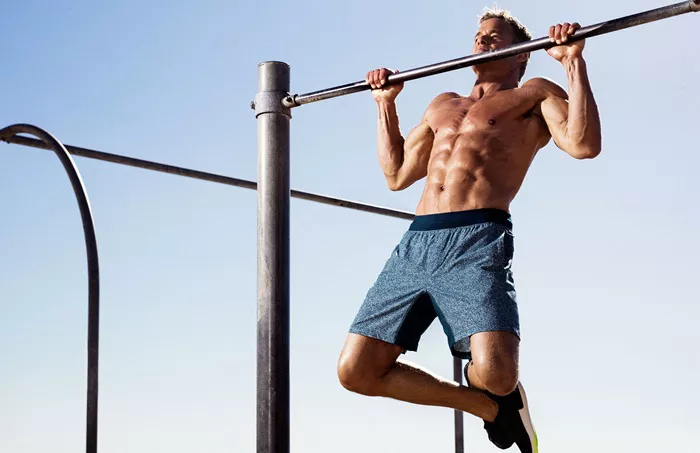Pull-ups are a fundamental upper-body strength exercise. They use your body weight for resistance. This makes them a classic compound movement. They are performed by gripping an overhead bar and pulling your body upward. Your chin should rise above the bar. Pull-ups work multiple muscles at once. This makes them efficient and effective.
Understanding the Pull-Up Movement
Basic Mechanics
To perform a pull-up, you need a sturdy overhead bar. Grip the bar with your palms facing away from you. Your arms should be shoulder-width apart. Engage your core. Pull your chest upward. Pause when your chin is over the bar. Lower yourself slowly. This completes one repetition.
Muscles Targeted
Pull-ups mainly target your upper body. The primary muscles worked include:
- Latissimus dorsi (lats)
- Biceps brachii
- Trapezius
- Rhomboids
- Forearms
- Core muscles
Pull-ups also engage stabilizing muscles. This includes the shoulders and lower back. The exercise strengthens the body holistically.
Benefits of Pull-Ups
Improves Upper Body Strength
Pull-ups are highly effective for building strength. They enhance your back, arms, and shoulder muscles. Regular training boosts muscle endurance and power.
Enhances Grip Strength
Your grip is vital in pull-ups. Holding your body weight trains your forearms and hands. Improved grip supports other exercises like deadlifts and rows.
Promotes Core Activation
Pull-ups engage your core for stability. Your abdominal and oblique muscles are activated. This helps improve posture and balance.
Supports Functional Fitness
Pull-ups mimic real-life movements. They improve coordination and control. This benefits sports and daily activities.
Boosts Mental Toughness
Pull-ups are challenging. They require determination. Consistent training builds discipline and confidence.
Types of Pull-Ups
Standard Pull-Up
This is the classic form. Palms face away from you. Hands are shoulder-width apart. It targets the upper back and biceps.
Chin-Up
Chin-ups use an underhand grip. Palms face toward you. This variation emphasizes the biceps more.
Wide-Grip Pull-Up
Hands are placed wider than shoulder-width. This puts more strain on the lats. It increases upper back muscle engagement.
Close-Grip Pull-Up
Hands are closer than shoulder-width. It shifts focus to the center of the back and arms.
Neutral-Grip Pull-Up
Palms face each other. This grip is easier on the wrists and shoulders. It works the arms and upper back efficiently.
Weighted Pull-Up
Weights are added to increase resistance. This is for advanced trainers. It builds maximum strength and muscle mass.
Pull-Up vs Chin-Up
The difference lies in grip. Pull-ups use an overhand grip. Chin-ups use an underhand grip. Both target the back and arms. Chin-ups tend to recruit more biceps. Pull-ups engage more back muscles. Both exercises are valuable in any workout program.
Beginner Tips for Pull-Ups
Start with Assisted Pull-Ups
Use a resistance band or an assisted pull-up machine. These tools reduce the weight your body lifts. Gradually reduce assistance over time.
Practice Negative Pull-Ups
Jump or step up to the top of the pull-up. Lower yourself slowly. This builds strength in the same muscles used in the full motion.
Focus on Form
Quality matters more than quantity. Maintain proper posture. Avoid swinging or using momentum.
Train Your Grip
Use exercises like dead hangs. Strengthen your forearms and hands. This will improve pull-up performance.
Incorporate Accessory Exercises
Exercises like rows and lat pull-downs help. They develop the muscles needed for pull-ups.
Pull-Ups as an Anaerobic Exercise
Pull-ups are a form of anaerobic exercise. They involve short bursts of strength and power. There is no reliance on oxygen for energy. This makes pull-ups effective for muscle growth and endurance. Unlike cardio, anaerobic exercises build strength quickly. Pull-ups are an ideal part of any anaerobic training plan.
How to Incorporate Pull-Ups into Your Routine
Warm-Up First
Always begin with a warm-up. This prepares your muscles. Jumping jacks, arm circles, or light cardio are good options.
Use a Pull-Up Bar at Home
Install a pull-up bar in a doorway or garage. This allows daily practice. Consistency improves results.
Track Your Progress
Set clear goals. Track reps and sets. Gradually increase your performance.
Rest and Recover
Allow your muscles time to heal. Avoid overtraining. Rest is essential for muscle growth.
Combine with Other Exercises
Pull-ups pair well with push-ups, squats, and dips. This creates a full-body workout. For heart health, include cardio workouts as well.
Common Pull-Up Mistakes
Incomplete Range of Motion
Don’t stop halfway. Lower your body completely. Bring your chin above the bar every time.
Swinging or Kipping
Avoid using momentum. Keep your body steady. Control each movement.
Neglecting Other Muscle Groups
Balance your workout. Train legs and core. This improves overall strength and posture.
Tracking Improvement with Pull-Ups
Use a journal. Note how many reps you complete weekly. Add more sets or reps as you grow stronger. Celebrate each milestone.
Advanced Pull-Up Techniques
Muscle-Ups
This is a combination of a pull-up and dip. Pull your chest above the bar. Then press up. It requires power and skill.
Archer Pull-Ups
Pull your body to one side. Extend the opposite arm. Alternate sides. This builds unilateral strength.
One-Arm Pull-Ups
This is an elite movement. Use one arm only. It needs immense strength and balance. Practice with caution.
Using Pull-Ups for Weight Loss
While not a typical cardio workout, pull-ups can aid weight loss. They burn calories. They build lean muscle. More muscle means a higher metabolism. Combine with cardio and a healthy diet for best results.
Safety Tips for Pull-Ups
- Check your bar’s stability before use.
- Warm up your muscles.
- Start slowly. Avoid overexertion.
- Maintain proper form to prevent injury.
- Rest between sets and workouts.
Conclusion
Pull-ups are one of the most effective bodyweight exercises. They build strength, muscle, and endurance. They challenge your upper body and core. With dedication and proper form, anyone can master them. Include pull-ups in your anaerobic training or full-body fitness routine. Over time, you’ll see noticeable improvement in strength, posture, and confidence.

